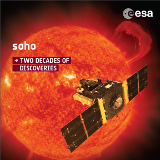ESA Science & Technology - Publication Archive
Publication archive
Publication archive
Context. Over the past 40 years, helioseismology has been enormously successful in the study of the solar interior. A shortcoming has been the lack of a convincing detection of the solar g modes, which are oscillations driven by gravity and are hidden in the deepest part of the solar body – its hydrogen-burning core. The detection of g modes is expected to dramatically improve our ability to model this core, the rotational characteristics of which have, until now, remained unknown.
Aims. We present the identification of very low frequency g modes in the asymptotic regime and two important parameters that have long been waited for: the core rotation rate, and the asymptotic equidistant period spacing of these g modes.
Methods. The GOLF instrument on board the SOHO space observatory has provided two decades of full-disk helioseismic data. The search for g modes in GOLF measurements has been extremely difficult because of solar and instrumental noise. In the present study, the p modes of the GOLF signal are analyzed differently: we search for possible collective frequency modulations that are produced by periodic changes in the deep solar structure. Such modulations provide access to only very low frequency g modes, thus allowing statistical methods to take advantage of their asymptotic properties.
Results. For oscillatory periods in the range between 9 and nearly 48 h, almost 100 g modes of spherical harmonic degree 1 and more than 100 g modes of degree 2 are predicted. They are not observed individually, but when combined, they unambiguously provide their asymptotic period equidistance and rotational splittings, in excellent agreement with the requirements of the asymptotic approximations.
[Remainder of abstract truncated due to character limitations]

